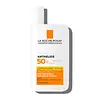Idun Minerals Liquid Mineral Foundation Nordic Veil Versus La Roche-Posay Anthelios Ultra Fluid Face Lotion SPF 50+
What's inside
What's inside
 Key Ingredients
Key Ingredients

 Benefits
Benefits

 Concerns
Concerns

 Ingredients Side-by-side
Ingredients Side-by-side

Water
Skin ConditioningIsohexadecane
EmollientIsoamyl Laurate
EmollientDipentaerythrityl Tri-Polyhydroxystearate
EmollientGlycerin
HumectantSorbitan Isostearate
EmulsifyingPolyglyceryl-3 Polyricinoleate
EmulsifyingSilica
AbrasiveSynthetic Wax
AbrasiveDisteardimonium Hectorite
StabilisingSilica Dimethyl Silylate
EmollientTocopheryl Acetate
AntioxidantIsononyl Isononanoate
EmollientPhenethyl Alcohol
MaskingMagnesium Sulfate
Mica
Cosmetic ColorantHydroxyethylcellulose
Emulsion StabilisingCaprylhydroxamic Acid
Disodium EDTA
Pyrus Malus Seed Oil
EmollientLauroyl Lysine
Skin ConditioningCI 77891
Cosmetic ColorantCI 77492
Cosmetic ColorantCI 77491
Cosmetic ColorantCI 77499
Cosmetic ColorantWater, Isohexadecane, Isoamyl Laurate, Dipentaerythrityl Tri-Polyhydroxystearate, Glycerin, Sorbitan Isostearate, Polyglyceryl-3 Polyricinoleate, Silica, Synthetic Wax, Disteardimonium Hectorite, Silica Dimethyl Silylate, Tocopheryl Acetate, Isononyl Isononanoate, Phenethyl Alcohol, Magnesium Sulfate, Mica, Hydroxyethylcellulose, Caprylhydroxamic Acid, Disodium EDTA, Pyrus Malus Seed Oil, Lauroyl Lysine, CI 77891, CI 77492, CI 77491, CI 77499
Drometrizole Trisiloxane 7%
UV AbsorberBis-Ethylhexyloxyphenol Methoxyphenyl Triazine 5%
Skin ConditioningEthylhexyl Salicylate 5%
UV AbsorberOctocrylene 5%
UV AbsorberButyl Methoxydibenzoylmethane 3%
UV AbsorberHomosalate 2%
Skin ConditioningPhenylbenzimidazole Sulfonic Acid 0.5%
UV AbsorberWater
Skin ConditioningAlcohol Denat.
AntimicrobialSilica
AbrasiveIsopropyl Myristate
EmollientGlycerin
HumectantDiisopropyl Sebacate
EmollientC12-22 Alkyl Acrylate/Hydroxyethylacrylate Copolymer
StabilisingPropanediol
SolventPerlite
AbsorbentTocopherol
AntioxidantTriethanolamine
BufferingCaprylyl Glycol
EmollientTrisodium Ethylenediamine Disuccinate
Disodium EDTA
Hydroxyethylcellulose
Emulsion StabilisingAcrylates/C10-30 Alkyl Acrylate Crosspolymer
Emulsion StabilisingDrometrizole Trisiloxane 7%, Bis-Ethylhexyloxyphenol Methoxyphenyl Triazine 5%, Ethylhexyl Salicylate 5%, Octocrylene 5%, Butyl Methoxydibenzoylmethane 3%, Homosalate 2%, Phenylbenzimidazole Sulfonic Acid 0.5%, Water, Alcohol Denat., Silica, Isopropyl Myristate, Glycerin, Diisopropyl Sebacate, C12-22 Alkyl Acrylate/Hydroxyethylacrylate Copolymer, Propanediol, Perlite, Tocopherol, Triethanolamine, Caprylyl Glycol, Trisodium Ethylenediamine Disuccinate, Disodium EDTA, Hydroxyethylcellulose, Acrylates/C10-30 Alkyl Acrylate Crosspolymer
 Reviews
Reviews

Ingredients Explained
These ingredients are found in both products.
Ingredients higher up in an ingredient list are typically present in a larger amount.
Disodium EDTA plays a role in making products more stable by aiding other preservatives.
It is a chelating agent, meaning it neutralizes metal ions that may be found in a product.
Disodium EDTA is a salt of edetic acid and is found to be safe in cosmetic ingredients.
Learn more about Disodium EDTAGlycerin is already naturally found in your skin. It helps moisturize and protect your skin.
A study from 2016 found glycerin to be more effective as a humectant than AHAs and hyaluronic acid.
As a humectant, it helps the skin stay hydrated by pulling moisture to your skin. The low molecular weight of glycerin allows it to pull moisture into the deeper layers of your skin.
Hydrated skin improves your skin barrier; Your skin barrier helps protect against irritants and bacteria.
Glycerin has also been found to have antimicrobial and antiviral properties. Due to these properties, glycerin is often used in wound and burn treatments.
In cosmetics, glycerin is usually derived from plants such as soybean or palm. However, it can also be sourced from animals, such as tallow or animal fat.
This ingredient is organic, colorless, odorless, and non-toxic.
Glycerin is the name for this ingredient in American English. British English uses Glycerol/Glycerine.
Learn more about GlycerinHydroxyethylcellulose is used to improve the texture of products. It is created from a chemical reaction involving ethylene oxide and alkali-cellulose. Cellulose is a sugar found in plant cell walls and help give plants structure.
This ingredient helps stabilize products by preventing ingredients from separating. It can also help thicken the texture of a product.
This ingredient can also be found in pill medicines to help our bodies digest other ingredients.
Learn more about HydroxyethylcelluloseSilica, also known as silicon dioxide, is a naturally occurring mineral. It is used as a fine, spherical, and porous powder in cosmetics.
Though it has exfoliant properties, the function of silica varies depending on the product.
The unique structure of silica enhances the spreadability and adds smoothness, making it a great texture enhancer.
It is also used as an active carrier, emulsifier, and mattifier due to its ability to absorb excess oil.
In some products, tiny microneedles called spicules are made from silica or hydrolyzed sponge. When you rub them in, they lightly polish away dead skin layers and enhance the penetration of active ingredients.
Learn more about SilicaWater. It's the most common cosmetic ingredient of all. You'll usually see it at the top of ingredient lists, meaning that it makes up the largest part of the product.
So why is it so popular? Water most often acts as a solvent - this means that it helps dissolve other ingredients into the formulation.
You'll also recognize water as that liquid we all need to stay alive. If you see this, drink a glass of water. Stay hydrated!
Learn more about Water